Getting Maryland blue crabs from Bay to table is hard. And it’s only getting harder. Follow the voyage of a boatload of jimmies and sooks with the people whose livelihoods depend on them
Hoopersville, Maryland, is dark at 4:30 in the morning. Not just any dark. An all-consuming, sight-robbing blackness untempered by the 70,000 street lights that dilute the night sky for us Baltimore boys. I’m a fish out of water over here on Hoopers Island, deep in the rural recesses of the Eastern Shore. This mini archipelago of slender, bridge-connected slivers of land rises (just barely) out of the Chesapeake Bay on the west and the Honga River on the east. Hoopersville is the last place the headlights cut across before the blacktop dissipates into a swampy expanse of cordgrass, needlerush, and wind-sculpted loblolly pine. Then open water.
“Hoopersville? It’s not the end of the world—but you can see it from there,” a local wag put it to me up in Cambridge, the Dorchester County seat. You can’t see anything at the moment from a harborside parking lot of crushed oyster shells.
The whitewashed United Methodist Church across the way is ethereal, hazy. A low, grinding drone of electric motors is in the air. Refrigeration units, most likely. At least one of the shadowy, indistinct boxy structures by the harbor is a seafood company. This noise, combined with what you don’t hear—pinging sailboat masts—lets you know this tiny harbor is for labor, not leisure.
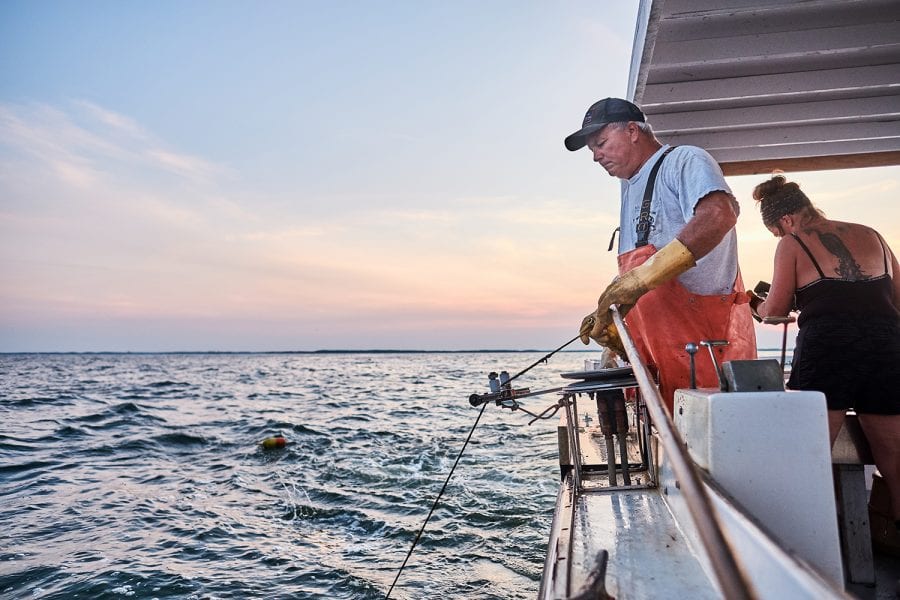
This is crab country. Or, as denizens here playfully dub it, the “White Boot Republic.” You can buy T-shirts emblazoned with this state-within-a-state name at the Hoopers Island General Store, a homespun affair up the road with a hodgepodge of offerings, from fan belts to fried egg sandwiches. It refers to the rubber footwear preferred by watermen, a Chesapeake term for the hard-bitten lot living off the Bay’s fickle bounty. “It’s an Eastern Shore thing—you wouldn’t understand” completes the shirt’s messaging.
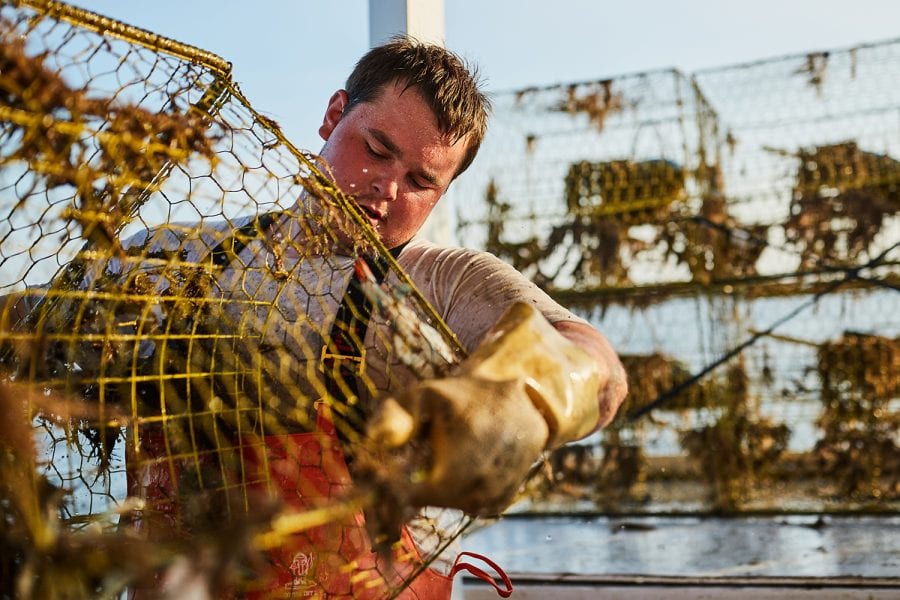
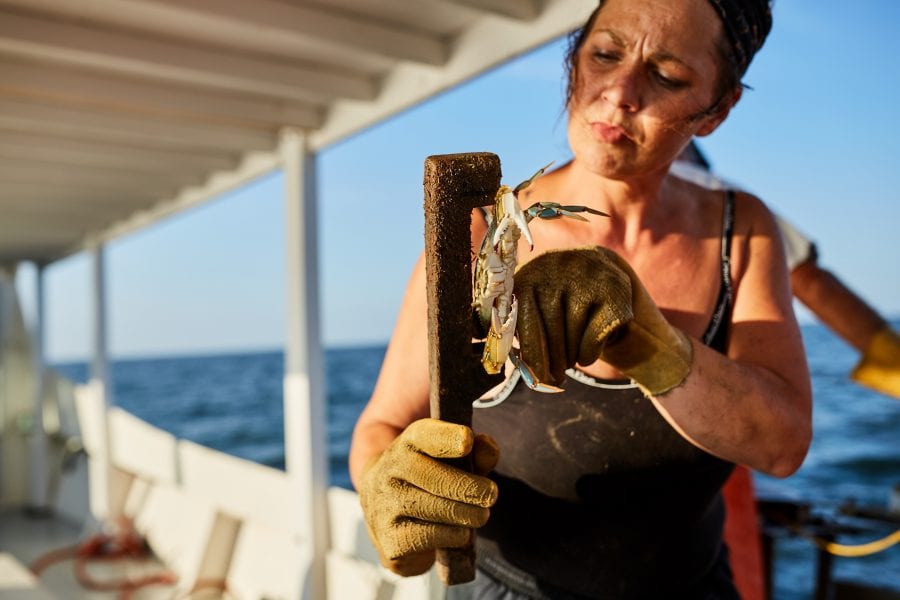
But wanting to understand brought me here in the pre-dawn gloom. As a lifelong Marylander, I’ve eagerly eaten crab every which way: steamed spicy in the shell, fried or broiled in moist cakes, doused in creamy, sherry-tinged soups. I’ve even caught a few with chicken necks and string. We love our blue crabs—Callinectes sapidus—the beautiful, savory swimmer. News of their numbers in the Bay is, well, big news here. And the latest word is encouraging. Counts of crabs hibernating in the winter mud suggest a population on the rebound, per- haps to “best in a generation” levels, as one outlet put it. Break out the Old Bay! Or, maybe, not so fast. I’ve heard all this before, and for years now you’ve needed a second mortgage to cover a picnic table with steamed jumbos. I’ve arranged to check out the state of the state crustacean—our culinary gift to the world—from folks with first-hand knowledge.
The teachers soon arrive: Pickup trucks emerging from the darkness, wheeling about to unload wooden bushel baskets and boxes of bait. Boat engines roar to life. I scramble aboard Captain Scott Todd’s 47-foot deadrise Endless Summer, a distinctive type of shallow-draft workboat with forward cabins and long rear decks. We’re on the move by 5 am. The night sky morphs into weak twilight as we pass Muddy Hook Cove en route to the open Bay where four hundred crab pots await, down off Bloodsworth Island northward to Tom’s Point. The two-person crew is mother and son, and yes, that’s uncommon. Teenaged Shane Abbott is a pot shaker, his mother Michelle Van Dyke a culler. I’ll have plenty of time to observe what these titles entail. The midday sun will be in our eyes when we return.
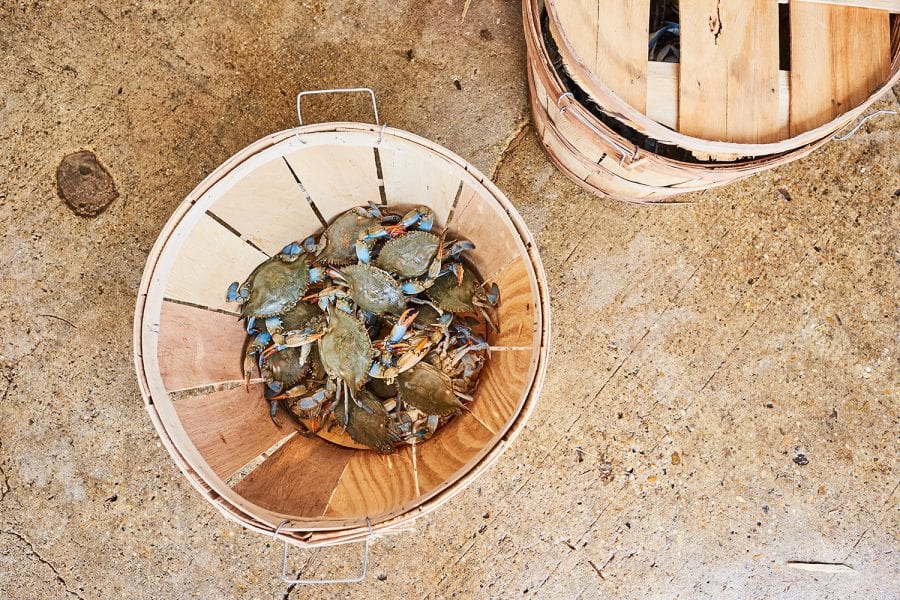
From Bay to Bushel
Todd is a fifth-generation waterman—despite a mother from watermen stock who begged him to take up dry-land pursuits. “We’ll find college money somewhere,” she implored. But, with the Bay in his DNA, he rebuffed all temptation and instead followed a familial path to the Chesapeake. The ruddy-faced 55-year-old has a distinct Shore drawl and a shirt reading: “Been there crabbed that.” After more than three decades on the water, there’s some truth in this sartorial bluster. He’s seen crab populations wax and wane, including a decade-long downturn beginning in the late ’90s. But when asked about his roughest stretch as waterman, he doesn’t hesitate: “It’s right now!”
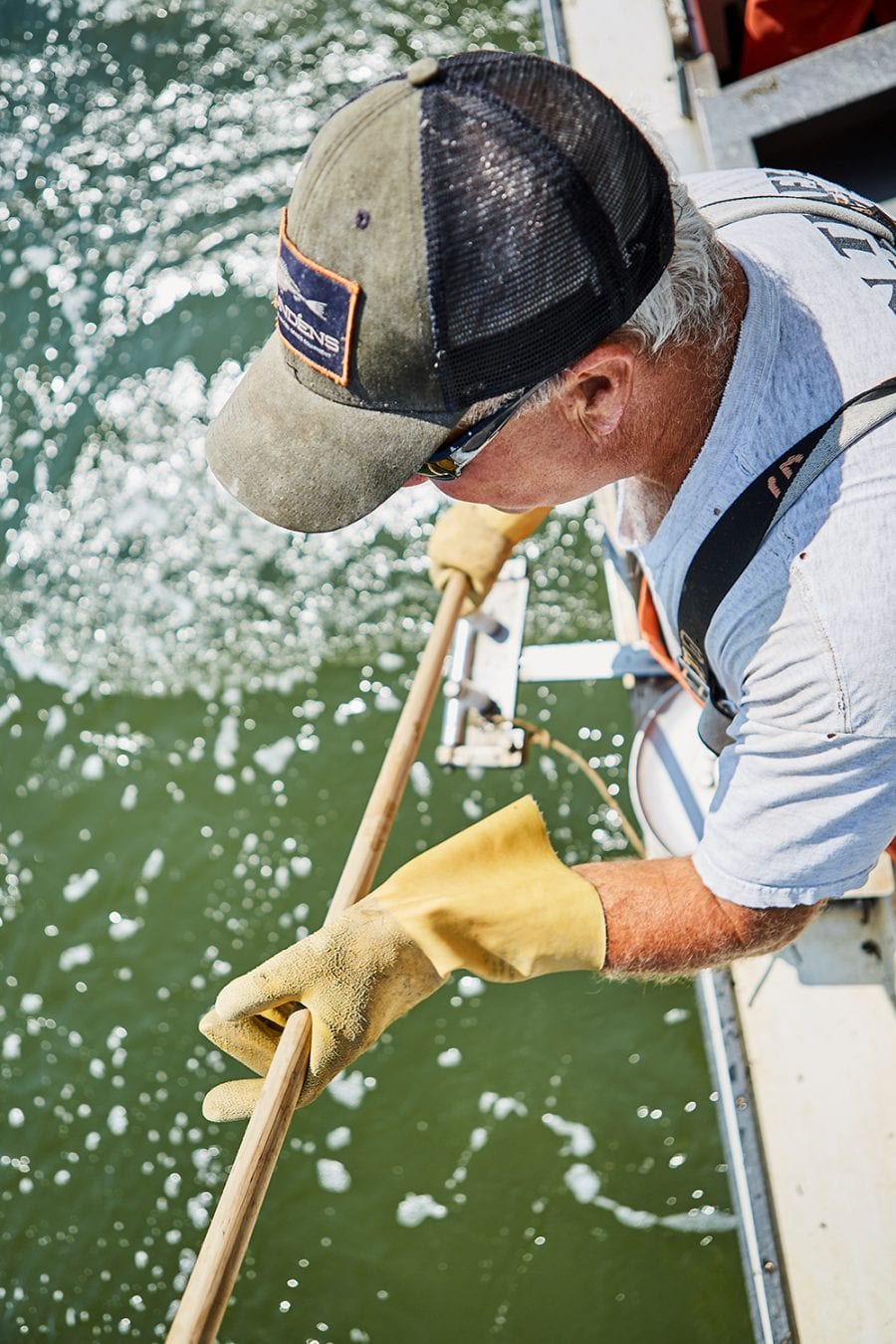
The issue is oysters, more than crabs. Watermen crab in the warmer months and dredge oysters in winter. (Netting striped bass—called rockfish up this way—is also in the mix.) But state regulators have reduced the amount of bottom where watermen are allowed to seek the bivalves, creating off-limit oyster sanctuaries up many of the tributaries. These efforts are driven by conservationists who see oysters not as something to be spritzed with lemon, but as natural filters cleaning Bay water. “The sanctuaries are such a mess that we didn’t even go out oystering at all last year,” Todd says. He sees the accumulating regulations as rubbing out a way of life, figuring that fewer than half of the state’s 5,500 commercial fishing licenses are in the hands of full-time watermen. And they’re an aging bunch, most over 50. “Once we’re done with watermen, the only place you are going to be able to get seafood is the frozen food section at Costco,” he laments.
I’m sympathetic to his plight and hope a middle ground can be found. But it’s complicated. While the Bay can feel remote, the nation’s largest estuary sits in the shadow of the fourth-most populous metro area—nearly 10 million people in Baltimore and Washington, DC. Development strains the ecosystem in myriad ways. And while jurisdictions in proximity to the Bay have been upgrading wastewater plants, changing farming practices, and taking other eco-positive steps, the watershed touches six states, from above Binghamton, New York, down to Lynchburg, Virginia. Change is less urgent where the Bay is a distant body.
But now to work. The first pot is pulled at 5:41 am. From a starboard perch, Todd controls the boat with three levers, guiding it along the strand of buoys connected to pots—wire mesh rectangular traps—on the Bay bottom. Like Ahab wielding a harpoon, he uses a long hook to snag the line below a buoy, drawing it up to catch on a winch that pulls the pot to the surface. Abbott then has three jobs to do, and about 20 seconds to do them.
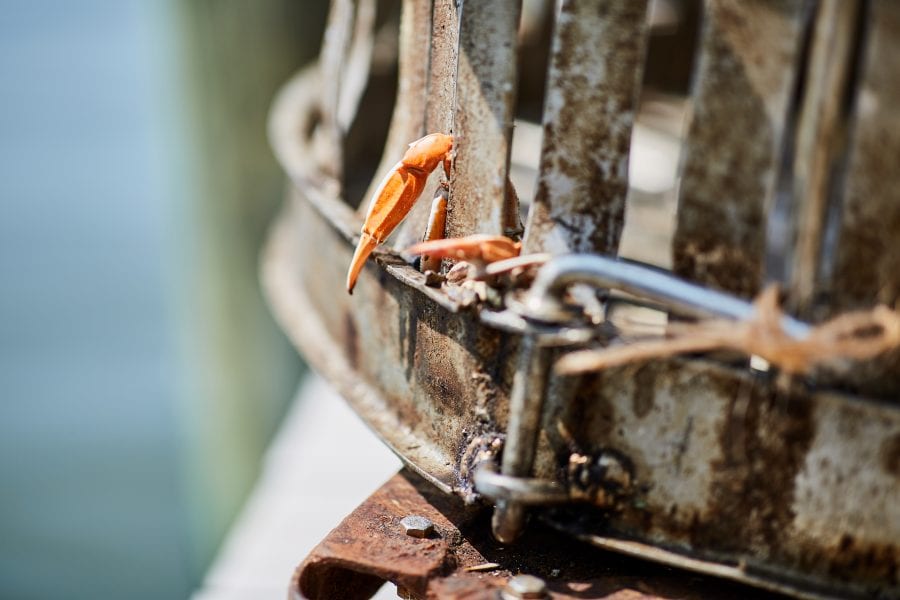
(I timed him.) With the pot tilted to his right, he opens the bait door to dump its fetid contents overboard and then opens the crab holding area, or “parlor,” below; tilting the pot to the left, he shakes it to send captured crabs tumbling into the culling box, then adds new bait. (Spot are being used today.) Soon enough, the pot is resting on the gunwale ready to drop back in as Todd hooks the next buoy. Unbait, shake, rebait, repeat.
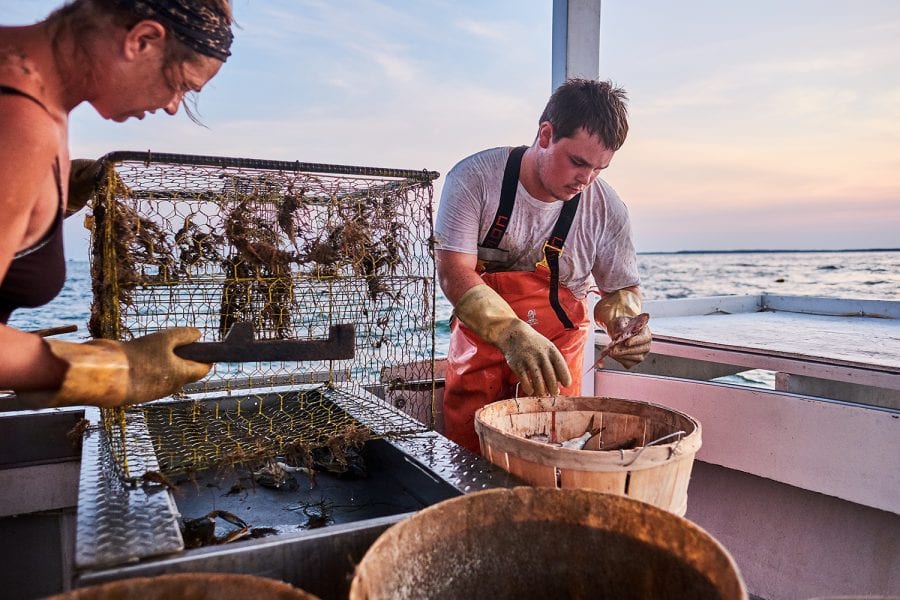
“I’ve been crabbing since I was 4 years old; it’s in my blood,” Abbott says. It’s perhaps too soon to ask the fresh-faced recent high school grad with cat-lick chin stubble if he sees this as a life calling. But his eyes take on a certain twinkle when asked if he envisions himself piloting a deadrise someday. “Oh, I think about it,” he says. His mother’s job at the culling box is to sort a writhing, pinching tangle of crabs by size and sex. Thick gloves are a must. Jimmies (males) are easily differentiated from sooks (females) by the shape of the “apron” on the animal’s underside.
(There are state limits on the number of females that can be caught.) Anything under 5.25 inches across gets tossed overboard. Van Dyke, too, has a Bay-water background and recently retreated from a desk job in insurance. “I missed being outside,” she says. “It’s hard work, but a bad day on the water is better than a good day in an office. Wait until you see the sunrise—you’ll understand then.” There aren’t many waterwomen, and the sheer physicality of it is one ready reason. “Most watermen are married,” she adds. “I guess their wives don’t want women on the boats.”
As if there’d be time for any hanky-panky. The trio toils relentlessly, pausing to pull refreshments from an ice chest only while the boat’s repositioned for the next line of buoys. “That’s what I’m talking about,” Van Dyke suddenly exclaims mid-cull. Glancing eastward, the sun has successfully broken the horizon and invents new pinky-blue colors as beams bounce across the Bay. Stunning. But her eyes are soon back to the feisty, blue-green charges and the work at hand.
Never mind the glowing crab report, Todd says the crabbing has been lousy this season. Each pot should snag a dozen or more market- sized crabs. About half that amount is coming up. And so it goes. Crabs are a wily foe. “Just when you think you got ’em figured out they’ll make a fool of you,” he says. One theory suggests that the Bay’s changing salinity dynamics have moved the crabs around, as a soggy spring followed on the heels of the wettest year in Maryland history. Only the crabs know. In any event, the biggest, heaviest ones are caught in the fall.
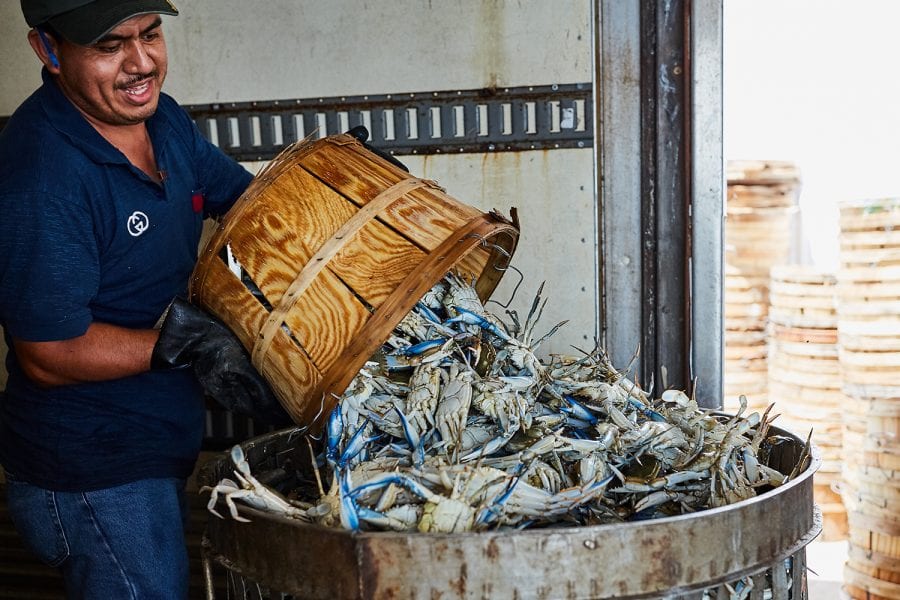
While crab feasts are traditionally thought of as a summertime treat, mallets will get more bang for one’s buck in October. (Not to say that autumnal Bay crabs are cheap, mind you; just shifting from very expensive to expensive.) By workday’s end—which is to say, noon—a dozen bushels of crabs come off Endless Summer and onto Todd’s truck, bound for sale at Clayton’s up in Cambridge. In a way of life full of tradition, this is but another. “My family’s been getting checks from their family for some hundred years,” Todd says.
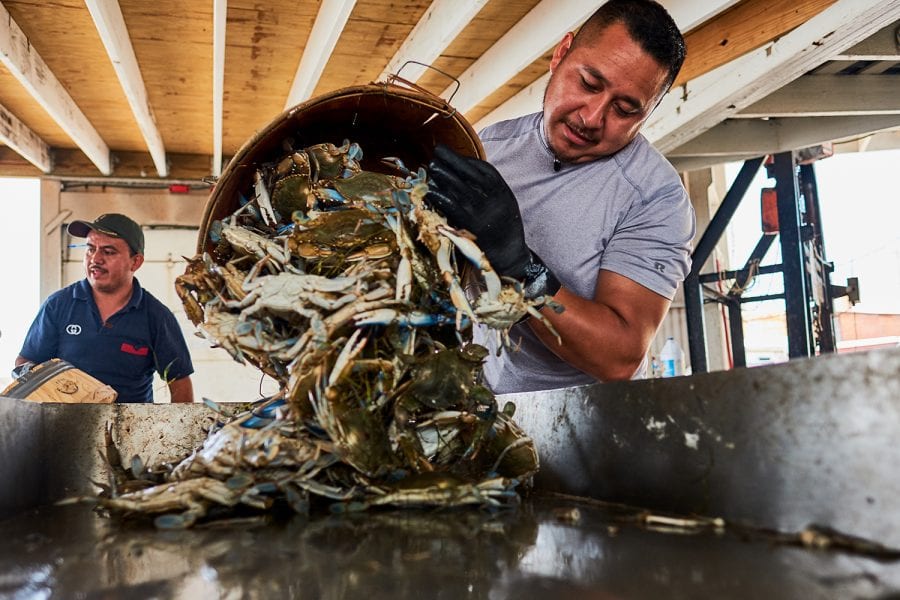
From Bushel to Lump
“Captain Johnnie” looms large in the family’s lore. Born in 1863 down in Accomack County on Virginia’s Eastern Shore, John Morgan Clayton was sailing the seas by 14, eventually captaining his own vessel sending lumber to the Caribbean and returning with tropical fruit. “Then, he married a local girl down in Hoopersville and that’s how this got started,” says Jack Brooks, Clayton’s great-grandson.
He’s referring to the J. M. Clayton Company, which bills itself as the World’s Oldest Crab Company. It’s hard to prove such a superlative, but the family firm has been steaming, picking, and packing crabs since the captain set up shop in 1890. Brooks and his siblings are the fourth generation at the helm, with a fifth learning the ropes. The patriarch’s final contribution came in 1921 when he relocated the company from Hoopers Island to Cambridge, drawn by its rail and steamship connections. Today the rambling assemblage of work-a-day structures alongside Cambridge Creek just off the Choptank River is an anomaly in a waterside overlooked by condos and a tiki bar.
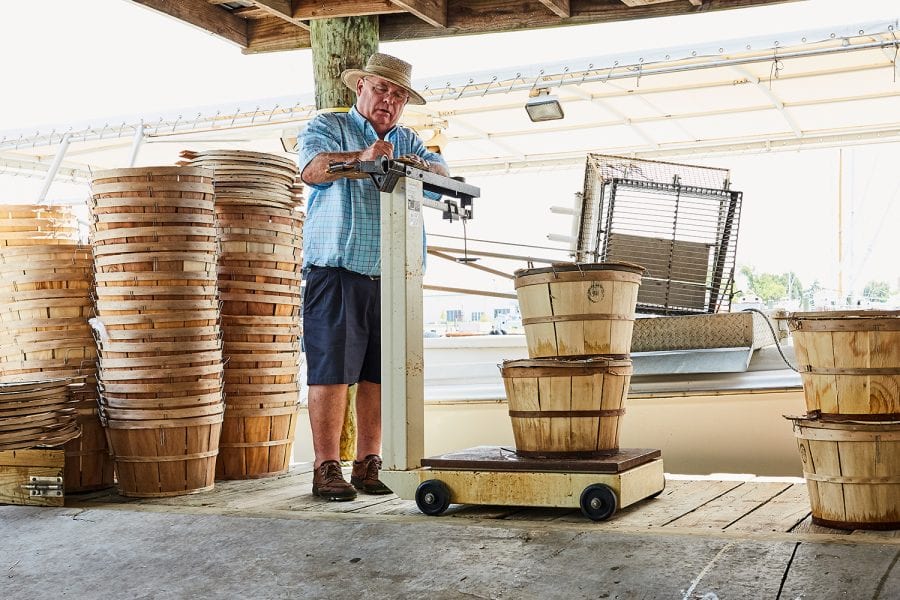
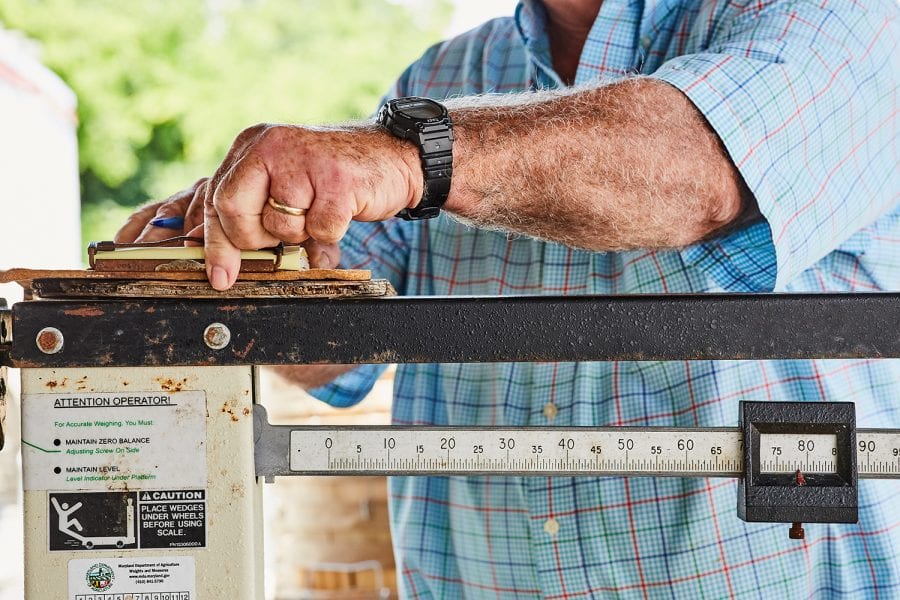
“This whole creek was littered with seafood packers, canneries, and boatyards and we’re the only seafood place left,” Brooks says, sweeping an arm across the vista. He’s dressed for a warm-weather workday in shorts and panama hat. The location has a key benefit: Crabs can come in by land and sea. Watermen working the Choptank’s numerous creeks and marshes just pull their boats up. No sooner has Mary Kathleen II unloaded its baskets than Miss Victoria slides in behind. That rapturous crab report is dead in the water here too. “The crabbing is terrible—don’t believe what you read,” a waterman shouts before motoring off. Baskets are weighed, and paper receipts dispensed. Checks are cut on Fridays. The biggest jimmies are separated and sold on live for the hard-shell market. The rest are bound for a pair of ten-bushel steamer baskets, eighty years old if a day.
“In Maryland, we steam crabs under pressure, which is good,” Brooks says. “Some colleagues down on the Gulf boil their crabs.” (This process, he notes dismissively, waterlogs the meat.) So far, much of the goings-on would be familiar to Captain Johnnie.
Then we walk over to the picking house where dexterous hands dismantle the crabs. Women have traditionally done this work, and a generation or so ago all the pickers would have been locals. Today they are all Latinas, largely from Mexico, and all here on H-2B temporary work visas.
“The older pickers retired, and younger people here have more opportunities today and choose year-round work,” Brooks says of the change. “Our season ends around Thanksgiving and during the winter until April there are like six of us here.” Just over sixty women sit at tables speedily breaking apart crabs, giving ultimate deference to the pair of thumb-size nuggets of meat behind the swimming legs—the jumbo lumps. Latin pop plays gently overhead, though drowned out by the clatter of men pushing crab-loaded wheelbarrows and using what look like snow shovels to keep the tables heaped. Brooks’ son Troy earns his pay in these environs as the only member of the family speaking passable Spanish.
With piece-rate incentives in place, Brooks says fast, efficient pickers might run through a dozen bushels a shift and earn upward of $16 an hour. Many of his pickers return year after year. However, changes last season in how the government allocates migrant workers wreaked havoc in the local crab industry, leaving half of Maryland’s picking houses without pickers. Clayton was one of the lucky ones. While this year’s allotment process went smoother, labor uncertainty is just another headwind for the industry.
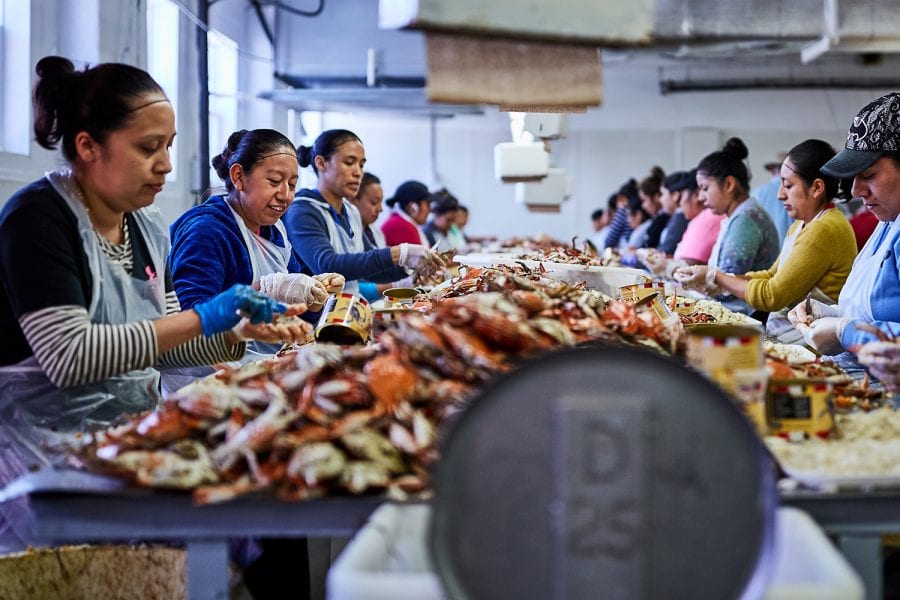
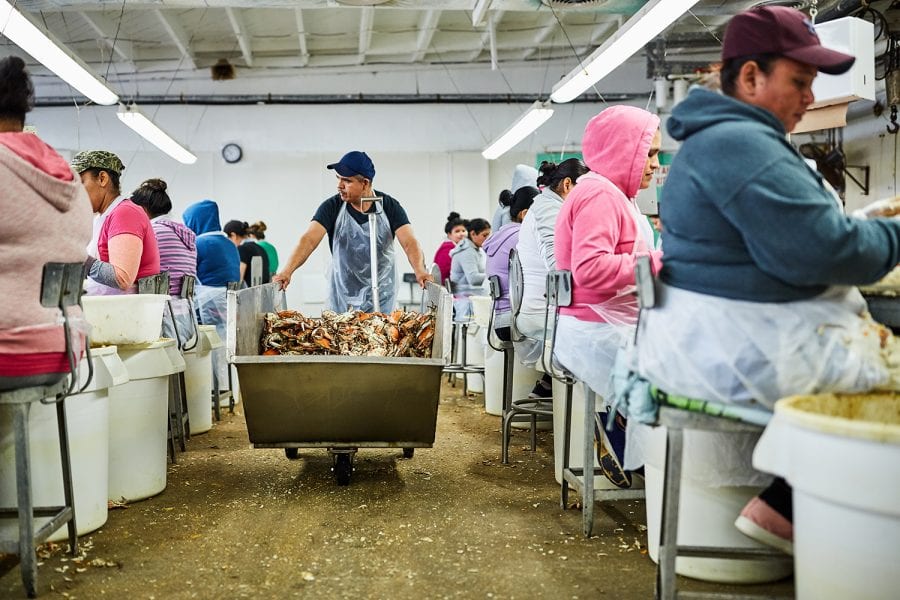
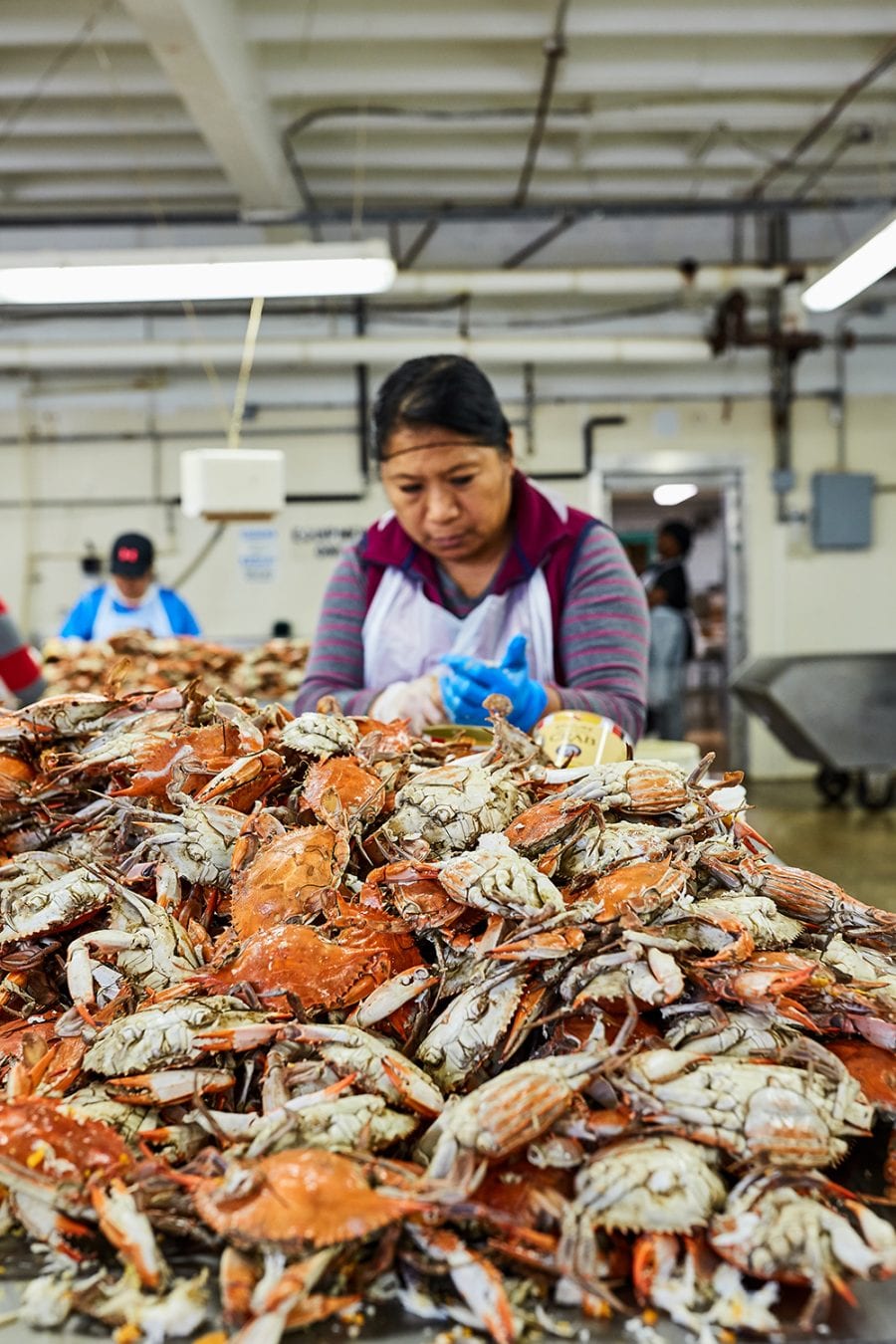
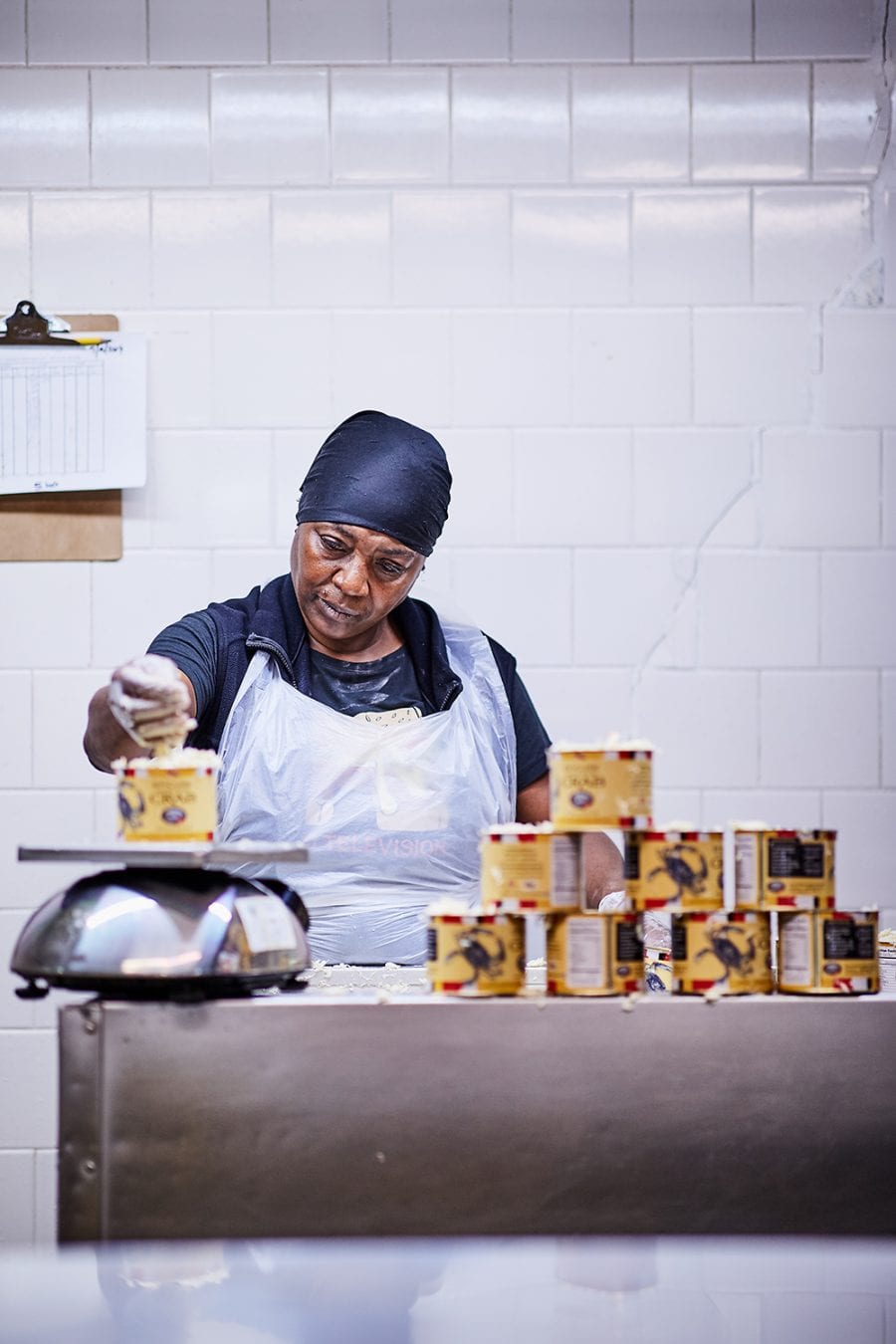
But rattling the Maryland crab trade much more than foreign workers has been foreign crabmeat. “Competition from Asia cost us a lot of our colleagues,” Brooks says. “In 1995, there were fifty-three companies in the state of Maryland doing what we do. Now there’s less than twenty.” Meat from various crab species comes in now from China, Thailand, Vietnam, Indonesia, India, Venezuela, and elsewhere— some probably in ships steaming up the Bay past working watermen. Phillips is a grand-old name in Maryland crab, and I remember the lines outside their Ocean City crab house in the 1970s. They helped pioneer overseas crab procurement to become a seafood juggernaut, now marketing a whole line of tubbed crab meat and frozen “Maryland-style” crab cakes using meat from Southeast Asia.
Brooks recalls that when imports killed the Maryland Crab Company over in Crisfield twenty-odd years ago, their equipment was bought by the Chesapeake Bay Maritime Museum in the tourist town of St. Michaels. Day-trippers gawk at it to this day. How has Clayton avoided becoming a museum piece?
“We were willing to change,” Brooks says. “We downsized. We used to have 165 people in here. We responded to the market to focus in on quality.” His crabmeat, marketed under the Epicure brand, is spendy. A pound tub of jumbo lump approaches $50. But the focus now is on consumers and chefs who want meat that’s not treated with chemicals or preservatives (as some imports are) from local crabs that are sustainably and responsibly harvested (as some imports aren’t).
Brooks may be the most biased person on the planet, but he feels Maryland blue crabs simply taste best, easily topping the exotic species from far-flung tropical climes. And since Maryland crabs fatten up before hibernating through chilly Chesapeake winters, he feels they’re fuller flavored than those from warmer domestic waters, such as the Gulf.
And he’s convincing others. Clayton now takes a booth at Boston’s teeming Seafood Expo, the country’s largest fisheries trade show. They hand out tiny cups of crab, often sparking the following back-and- forth with attendees who sample it:
“What’s in this?”
“Nothing but crab.”
“No, there’s something else—something sweet, rich.”
“It’s just crab. Maryland crab.”
Read also about Easton Maryland

Shrimp, Maryland Crab, and Rockfish Stew
share
trending content
-
New Restaurants in Arkansas
-
Shrimp and Grits: A History
by Erin Byers Murray -
Tea Cakes, A Brief History
by TLP Editors -
Gullah Geechee Home Cooking
by Erin Byers Murray -
A Cajun Christmas Menu
by TLP Editors
More From Key Ingredient
-
Key Ingredient: Preserved Lemons
-
Key Ingredient: How Do You N’duja?
-
In Season: Persimmons
-
Key Ingredient: No Small Peanuts
-
Key Ingredient: Barbecue Pickled Cabbage





